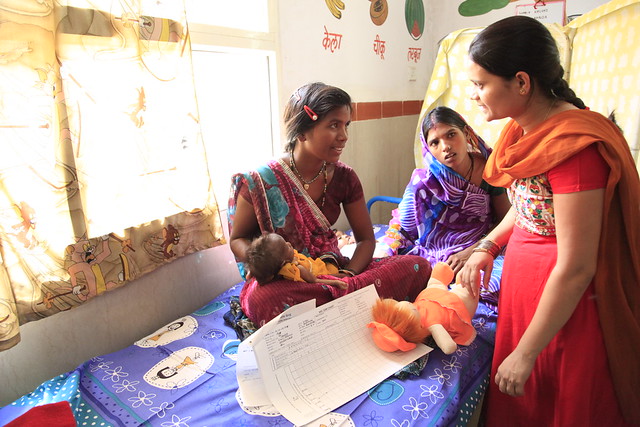Study reveals link between teenage pregnancy and child stunting

Auxillary Nurse Midwife Varsha speaks to young mother Kali, who has been referred with her severely malnourished daughter to the Nutrition Rehabilitation Centre in Badnavar, Dhar District of Madhya Pradesh. Her baby is two months old but weighed just 1.8kgs when she arrived at the centre five days ago. Kali is from a tribal area where it is still custom for babies to not be breastfed until they are a few days old. As a result many children are malnourished almost from birth. The Nutrition Rehabilitation Centres run by the Government of Madya Pradesh are supported by UK aid from the Department for International Development.
Source: India Science Wire (By Jyoti Singh)
Neucrad Health India June 1, 2019
A new study has found that in India stunting and under-weight were 11 percentage points more prevalent in children born to adolescent mothers than those born to adult mothers.
Conducted by International Food Policy Research Institute (IFPRI), the research also found that there was a strong relationship between teenage pregnancy and child under-nutrition because of several factors including lower educational attainment, poorer nutritional status, less access to health services during antenatal or postnatal period, sub-optimal complementary feeding practices and poorer living conditions of teenage mothers.
The study is based on data from the fourth round of National Family Health Survey during 2015-16. It was representative at both state and district levels and had covered six lakh households.
” It has found that 31% of married women in India gave birth by the age of 18 in 2016 due to societal pressure to consummate the marriage and low knowledge of reproductive health, among other factors. ”
It has found that 31% of married women in India gave birth by the age of 18 in 2016 due to societal pressure to consummate the marriage and low knowledge of reproductive health, among other factors. Adolescent mothers were more likely to be anaemic compared with adult mothers and anaemia was associated with reduced child growth. This finding is based on analysis of data relating to 60,097 mother-child pairs.
“As estimated 16 million girls aged 15-19 years give birth annually in the world and 95% of these births occur in low-income and middle-income countries. Reducing adolescent pregnancy can hasten its progress towards achieving the Sustainable Development Goals, particularly those related to poverty, health, nutrition, general wellbeing, equity, and education,” says study co-author, Phuong Hong Nguyen.
Pregnancy and childbirth complications are also leading cause of death among 15-19 year old girls globally. Adolescent pregnancy often results in school dropout affecting young women’s education and income. The prevalence of thinness among Indian women is twice as high in those married before 18 than those married after 24.
“Unfortunately, in India, early marriage and subsequent pregnancy is often not a deliberate choice, but rather the result of an absence of choices, and of circumstances beyond a girl’s control,” added Purnima Menon, a co-author of the study published in The Lancet Child and Adolescent Health.






